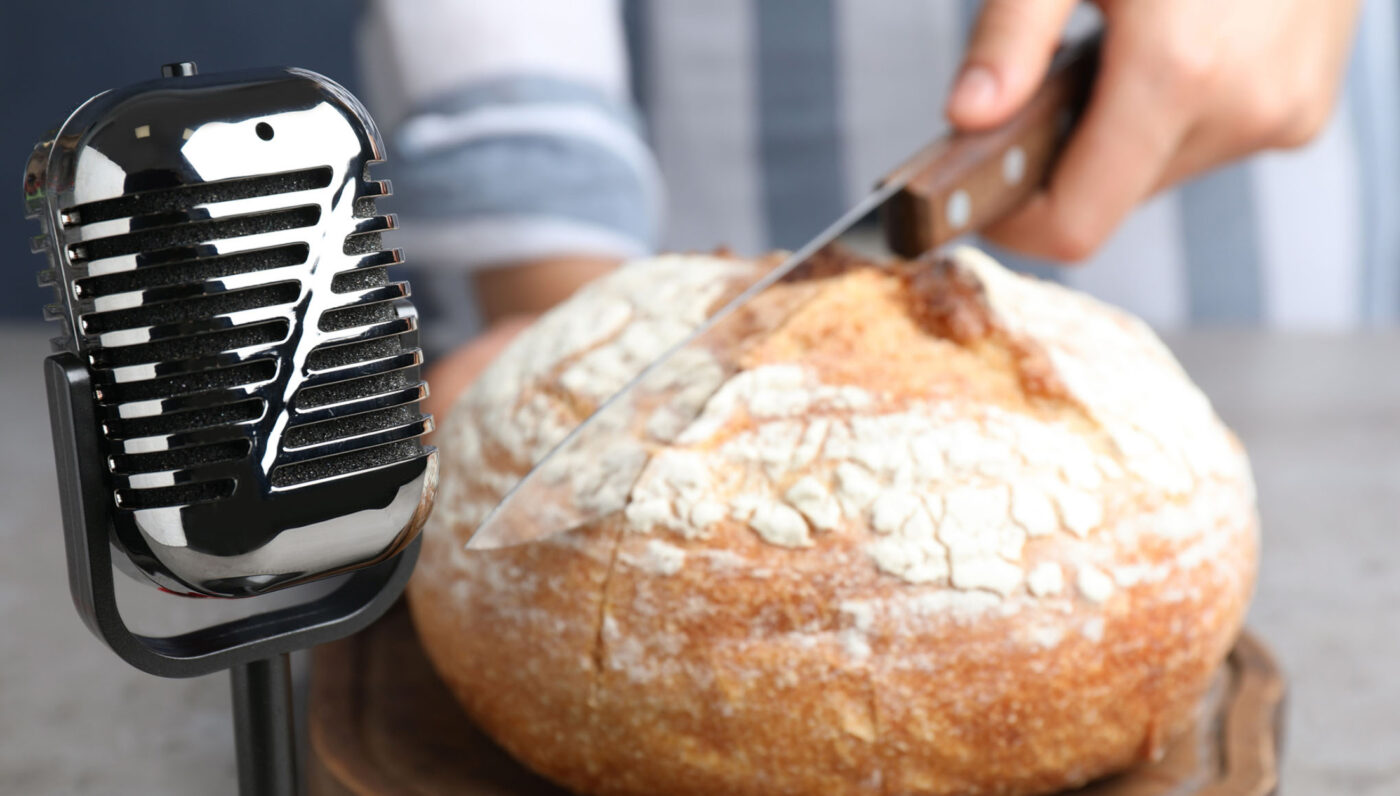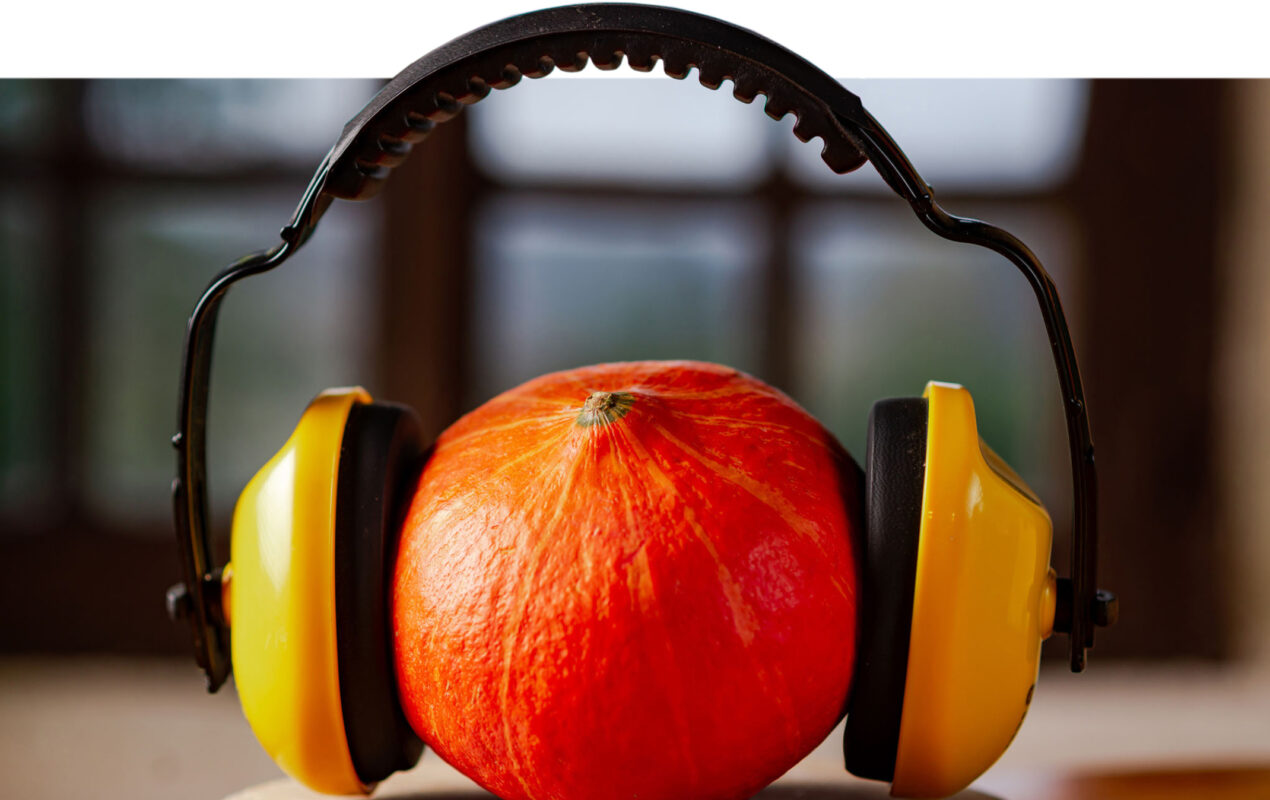Have you ever been captivated by the irresistible “slurping” sound in soup commercials? Or felt your mouth water at the sizzle of a juicy steak grilling to perfection? Ever wondered why restaurants make guacamole right at your table or why soda and beer ads play up the fizz and bubbles of a freshly opened can? And how about coffee ads! The sound of beans grinding and milk frothing makes it feel like you can already smell that freshly brewed cup. The secret lies in the tantalizing power of sonic hunger, and they sure know how to exploit it to entice your senses and elevate your culinary experience. Delving into the world of sonic hunger (also known as “ear hunger“) not only empowers you with conscious choice but also unlocks new dimensions of pleasure through sensory experiences.
A Symphony of Sights, Sounds, and Scents
A few years ago, I was walking through a bustling city, preoccupied with my thoughts and to-do list. With my mind racing, I barely noticed my surroundings as I hurried from one place to another. However, as I turned a corner, a street musician caught my attention. A young man with a guitar was passionately playing an enchanting melody that seemed to transcend time and space. I found myself captivated by his performance, so I decided to stop and listen for a while.
As I stood there, taking in the beautiful sounds of music, I started to see the scene around me with fresh eyes. I noticed the vibrant colors of the street art on a nearby wall, the laughter of children playing in a nearby park, and the warm, inviting aroma wafting from a local bakery. The once chaotic cityscape had transformed into a symphony of sights, sounds, and scents that left me feeling deeply connected to the world around me.
As I continued to watch, I noticed how his music was affecting others as well. People from all walks of life were stopping to listen, drawn in by the beauty of his performance. I saw strangers exchanging smiles, sharing a moment of joy and appreciation for the artistry unfolding before them. In that instant, it became clear to me how beauty can serve as a unifying force, bridging the gaps between us and fostering a sense of belonging and connection.
Sound can profoundly affect our everyday experiences. And you know, those sounds that accompany us at mealtime are no exception. Have you ever noticed the crunch of a crispy chip, the sizzle of frying onion, or the comforting hum of conversation in a busy restaurant? These sounds play a significant role in our enjoyment of food and are part of a concept known as ear hunger or sonic hunger.

Ear Hunger: The Auditory Side of Eating
Ear hunger is all about the sounds associated with food and eating, and it’s an essential aspect of mindful eating. By paying attention to the sounds we hear during meals, we can create more enriching and satisfying eating experiences. In fact, being more aware of the auditory side of our meals can help us develop a healthier and more enjoyable relationship with food.
I find it quite fascinating how sound can shape our eating habits. When we think about the sounds that accompany our meals, it’s like being a connoisseur of the culinary orchestra, tuning into each note and harmony as we savor every bite. It’s amazing how the symphony of sounds, from the crunch of fresh veggies to the sizzle of a juicy stirfry, can elevate our dining experiences to a whole new level.
Discovering the Hidden Treasure in Every Meal
By tuning into the sounds of food and our surroundings, we can enrich our eating experiences and heighten our appreciation of meals. Think about it: have you ever been to a fancy restaurant where the hushed ambiance and the soft clinking of silverware seem to amplify the flavors of your dish? Or imagine sitting down to dinner with your friends and family, sharing stories and laughter as the sounds of your meal create a delightful and comforting backdrop. With every bite, you become more aware of the unique “soundtrack” of your food, finding joy in each auditory nuance. It’s as if you’re discovering a hidden treasure that has always been there, just waiting to be noticed.
By embracing “ear hunger” and acknowledging the auditory aspect of our meals, we can develop a more mindful and meaningful relationship with food. We’ll start to notice the subtle differences between the crunch of a crisp apple and the crackle of a potato chip, empowering us to make healthier choices and appreciate each meal for the sensory experience it provides.
Being attuned to the soundscape of eating can also help us make more conscious choices about what, when, and how much we eat. When we’re aware of the sounds associated with our food, we can better recognize the cues that trigger our ear hunger and learn to distinguish them from genuine hunger. This can help us avoid overeating and develop a healthier relationship with food.

The Origins of Ear Hunger: A Culinary Symphony Awaits 🎵
The concept of ear hunger, or sonic hunger, might be new to some, but the idea of focusing on the sounds of our meals has been around for a while. Researchers and psychologists have been examining the role of auditory cues in our eating experiences and how they can impact our perception of food. One key figure in this field is Charles Spence, an experimental psychologist who has dedicated his career to exploring how our senses influence our dining experiences. Spence’s work highlights the importance of sound in our enjoyment of food, demonstrating how the crunch of a crispy chip or the sizzle of frying onion can actually enhance the taste of a dish.
You know, Brian Wansink, a researcher, did some really interesting experiments that showed how sounds can influence our cravings and the way we enjoy food. In one of his experiments, he gave people a glass of inexpensive wine and told them it was either from a “new winery in California” or “a new North Dakota winery.” Turns out, those who thought their wine was from North Dakota didn’t enjoy their wine or their food as much.
In another experiment, people ended up buying more French wine when French music played in the background, and more German wine when German music played. How cool is that? And get this, when people ate bittersweet toffee candies while listening to low-pitched music, they found the candies to be more bitter. But when they listened to high-pitched music, the candies tasted sweeter!
Dr. Charles Spence from Oxford University is an expert in how our senses work together. He even won an Nobel Award for his research on how changing the pitch and volume of a potato chip’s crunch can affect how fresh and crispy we think it is. Isn’t that wild?
One interesting story Dr. Spence tells is about how Magnum ice cream bars changed their chocolate coating because it was too messy. But people complained about the new coating because it didn’t make that satisfying “crack” sound when they bit into it. So, the company went back to the original, crunchier coating.

We tend to like crunchy, crispy, or crackling foods because they seem fresh. For example, Cheetos once had a slogan, “The cheese that goes crunch!” and Doritos claimed their chips made the loudest crack. And think about the satisfying slurp of a hot soup or the snap of a chocolate bar as you break it – these sounds can make us crave these foods even more.
Here are some more examples of how sounds can influence our cravings:
- Have you ever noticed how soup commercials often emphasize the “slurping” sound? That’s because a satisfying slurp can make the soup seem hotter and more flavorful, enticing us to enjoy a comforting bowl.
- When you pour cereal into a bowl, the sound of the cereal hitting the bowl can make you anticipate the crunchiness. This is why many cereal commercials include that pouring sound, making the cereal seem even more appetizing.
- The fizz and bubbles of a freshly opened soda are really enticing, aren’t they? That’s because the sound of carbonation can make us associate the drink with being refreshing and thirst-quenching.
- The sizzle of a juicy steak on a grill is a sound that makes our mouths water. It’s the sound of the Maillard reaction, which is a chemical process that creates the delicious flavors and aromas we associate with perfectly cooked meat. Hearing that sizzle just makes us crave it even more!
- Have you ever been to a restaurant where they make guacamole right at your table? The sound of the avocado being mashed and mixed with other ingredients can make the dish seem extra fresh and delicious, adding to the overall dining experience.
- You know those ice cream commercials where they show a scoop breaking through the creamy goodness? They use the sound of a scoop breaking through the frozen treat, creating a sense of creamy richness and enticing the viewer to indulge in the dessert. The sound makes you feel like you’re right there, ready to dive into that dessert. And that is how they try to get you hooked!
- Fast food ads with that oh-so-crispy fried chicken or french fries really know how to pull us in, don’t they? They frequently emphasize the crisp, crunching sound of their fried chicken or french fries, making them seem extra fresh, crispy, and irresistible. Because all that crunching sound makes our mouths water, and they know it!
- And let’s not forget about coffee! Coffee ads often play up the sound of beans being freshly ground or the hissing of steam as milk is frothed, evoking an atmosphere of freshly brewed, aromatic coffee that invites you to grab a cup and savor it. They use those sonic cues to make us crave our caffeine fix even more.
- Chip brands love to showcase the sound of a bag being opened and chips being munched on, making them seem extra crunchy and tempting, leading you to crave a satisfying crunch yourself.
- Candy ads often focus on the crackling sound of a wrapper being opened or the snap of a hard candy being bitten, suggesting freshness and a delightful sensory experience, making us eager to enjoy those sweet treats ourselves.
- The sound of pasta being stirred in a sauce or the sizzle of garlic and onions in a hot pan is often used to evoke the idea of a home-cooked, flavorful meal that promises to satisfy your taste buds. It’s hard not to crave that deliciousness!
- Many chocolate commercials feature the sound of a chocolate bar being snapped, followed by the gentle crackle of the chocolate melting in one’s mouth, creating an irresistible tempting sensation of indulgence and pleasure.
- And who can forget baking shows and commercials? The sounds of dough being kneaded, whipped cream being beaten, or a cake being sliced really warm our hearts and make us want to indulge in those tasty baked goods.

Did you know that when people eat while blindfolded and listening to white noise, they find the food to be less salty or sweet as the volume goes up? That’s why airplane and astronaut food needs lots of seasoning to taste good.
Being aware of our sonic cravings means noticing how sounds can make us hungry. To see how sounds affect your food, try eating half a meal with earplugs or noise-canceling headphones, then take them off and see if your food tastes different. Or, try eating in silence and focusing on the sounds of your meal, like making and eating toast. It’s really fascinating to see how much of a difference it can make!
These examples show that our enjoyment of food isn’t just about taste and texture but also about the sounds we hear while we eat. Next time you’re enjoying a meal, pay attention to the sounds your food makes and how it affects your overall dining experience. It might even lead you to discover new aspects of your favorite dishes or inspire you to try new foods based on the sounds they create.

So, whether it’s the crunch of a crispy chip, the satisfying slurp of soup, or the sizzle of a perfectly grilled steak, the sounds of our food play a significant role in our cravings and overall enjoyment. Recognizing the impact of these sonic cravings can lead us to appreciate our meals even more and better understand how sound influences our eating experiences.
ASMR: A Sensory Cousin to Ear Hunger 🎧
While ear hunger focuses on the sounds of food and eating, a related phenomenon called ASMR (Autonomous Sensory Meridian Response) has gained popularity in recent years. ASMR is a sensory experience characterized by a tingling sensation, usually triggered by specific sounds or visual stimuli. Although ASMR is not specifically about the sounds of eating, many people enjoy listening to videos of individuals eating various foods, as they find the sounds soothing and satisfying. In this way, ASMR can be seen as a sensory cousin to ear hunger, as both involve an appreciation for the auditory aspects of our experiences.
By understanding the origins of ear hunger and its connection to sensory experiences like ASMR, we can better appreciate the importance of the sounds of our meals. Tuning into the auditory aspects of eating can lead to a more mindful, satisfying, and joyful dining experience that truly delights all our senses.

Feast Your Ears: Discovering the Benefits of Mindful Eating and Ear Hunger Awareness
Being mindful of the sounds connected to eating and food preparation can bring a whole lot of benefits for our physical and emotional well-being. By tuning into the orchestra of noises that accompany our meals, we can better understand our own hunger and fullness cues, leading to a healthier relationship with food. This practice can be super helpful for those dealing with emotional eating, binge eating, or other disordered eating patterns. Let’s dive into the awesome advantages of becoming more attuned to the soundtrack of our dining experiences.
- Uncovering Your True Hunger and Satiety Cues 🔍 🧠
When we pay attention to the sounds of our food and eating, we become more present in the moment, which helps us recognize our true hunger and fullness signals. By telling the difference between actual hunger and ear hunger, we can avoid overeating or munching when we’re not really hungry. This awareness helps us make more mindful choices about what, when, and how much we eat, ultimately supporting a healthier bond with foo. - Amping Up Your Food Enjoyment 🎉 😋
Listening to the sounds of our meals can boost our sensory experience and help us appreciate flavors, textures, and aromas even more. This increased enjoyment can make us feel satisfied with smaller portions, so we feel content without overindulging. Plus, by savoring each bite, we’re more likely to notice when we’re full, preventing overeating. - Reduced Emotional Eating 🌈
Emotional eating is when we use food to deal with our feelings, like stress, sadness, or even boredom. By practicing mindful eating and focusing on the sounds of our food, we become more aware of the emotions driving our eating habits. This awareness lets us address the root causes of emotional eating and find healthier ways to handle our feelings instead of turning to food for comfort. - Support for Disordered Eating Patterns 🙌
People struggling with disordered eating patterns, like binge eating or restrictive eating, can benefit from ear hunger awareness and mindful eating. By paying attention to the sounds of food and eating, they can build a deeper connection with their body’s hunger and fullness cues, which helps overcome harmful eating habits and forge a healthier relationship with food. - Slowing Down and Savoring Each Bite 🐌 🐢
Focusing on the sounds of our meals pushes us to slow down and enjoy each bite, which can be great for digestion and weight management. Eating slowly lets our brain catch up with our stomach, giving it time to process fullness signals and avoid overeating. Plus, taking your time with eating leads to better digestion and a more enjoyable dining experience overall. - Strengthened Connection to Food and Its Origins 🌾
When we appreciate the sounds of our meals, we’re also more likely to think about where our food comes from and how it was prepared. This deeper connection to our food can inspire us to make more conscious choices about what we consume, going for more wholesome, nutritious, and ethically sourced ingredients.

PRACTICES
Tuning into Your Daily Meals with Mindfulness and Ear Hunger Awareness 🎧
Incorporating mindfulness and ear hunger awareness into your daily life is easy and natural. In fact, it can be a very satisfying experience! Here are some suggestions for experimenting with the soundscape of your meals and becoming more attuned to the symphony of sounds that accompany your dining experiences.

Mix Up Your Mealtime Playlist 🎶
Why not play around with different genres of music during your meals? From soothing classical tunes to peppy pop beats, each genre can create a unique atmosphere that may influence how you perceive and enjoy your food. You can even try themed dinners where the food and music complement each other – think Italian opera with a delicious pasta dish, or some reggae beats alongside a tropical fruit salad. The possibilities are endless!
For example, you could try pairing some jazz music with a New Orleans-style gumbo or a sushi dinner with traditional Japanese shamisen tunes. Pay attention to how the music affects the atmosphere and your perception of the food, and share your thoughts with friends or family members who join you
Embrace the Sound of Silence 🔇
Sometimes, it’s the absence of sound that can make us more aware of the auditory aspect of our meals. Try eating in silence, allowing yourself to fully focus on the sounds your food makes as you chew and swallow. You might be surprised by how much you can learn about your food and your eating habits when you remove all external distractions.
As an example, try preparing and eating a salad in silence. Focus on the sounds of washing and chopping vegetables, the crinkling of the salad bag, the snap of a cucumber, and the crunch of lettuce as you take a bite. Notice how these sounds contribute to your overall enjoyment of the meal.
Use Earplugs for an Immersive Experience 🎧
If you really want to enhance the auditory aspect of your eating experiences, try using earplugs during your meals. By blocking out external noise, you’ll be able to focus solely on the sounds of your food, helping you become more mindful of your eating and more aware of your body’s hunger and fullness cues.
For instance, while enjoying a bowl of cereal, wear earplugs and notice the amplified sounds of the cereal being poured into the bowl, the splash of milk, and the crunch as you chew each spoonful. This focused auditory experience can help you better appreciate the textures and flavors of your food.
Mindful Snacking: Savor Each Crunch, Crackle, and Pop 🍿
Next time you grab a snack, take a moment to really listen to the sounds it makes. Whether it’s the satisfying crunch of a carrot stick or the delightful snap of a chocolate bar, tuning into these sounds can make snacking more enjoyable and help you appreciate each bite.
Take a moment to enjoy a bag of popcorn mindfully. Listen to the sound of the bag opening, the kernels pouring into the bowl, and the satisfying crunch as you munch on the popcorn. By concentrating on these sounds, you’ll likely find that you’re more present and satisfied during your snack time.
Incorporate Mindfulness into Your Grocery Shopping 🛒
Bring your ear hunger awareness practice to the grocery store. As you shop, take a moment to listen to the sounds of different foods – the rustle of a bag of rice, the gentle tap of apples in a bin, or the crinkling of a package of cookies. By tuning into these sounds, you can develop a greater appreciation for the food you’re about to bring home and eat.
Choose Your Ingredients Mindfully 🥕
When selecting ingredients for your meal, take a moment to listen to the sounds they make. This could be the rustling of dried pasta, the snap of fresh green beans, or the hollow thud of a ripe watermelon. These sounds can give you an appreciation for the ingredients you’re working with and set the tone for your cooking session.
Tune into the Symphony of Meal Preparation 🎵
As you cook, pay close attention to the variety of sounds involved in the process. From the rhythmic chopping of vegetables to the sizzle of ingredients in a hot pan, each sound is an important part of the culinary symphony. By focusing on these sounds, you’ll not only become more connected with your meal but also more present in the moment, making cooking a more mindful and enjoyable experience.
Experiment with Different Cooking Techniques 🔥
Explore various cooking techniques, such as sautéing, roasting, or steaming, and observe how each method produces different sounds. For instance, the crackle of oil in a frying pan creates a different auditory experience than the gentle bubbling of a simmering stew. By experimenting with different techniques, you’ll gain a deeper understanding of how sounds contribute to the meal you’re preparing.
Savor the Sounds of Your Homemade Meal 🍽️
Once your meal is ready, take a moment to appreciate the sounds that emerge as you serve it. This could be the satisfying sound of a knife slicing through a freshly baked loaf of bread or the gentle clink of a ladle against a bowl as you serve up a steaming hot soup. As you eat, immerse yourself in the symphony of sounds produced by your homemade meal and enjoy the fruits of your labor.
Listen to the Sounds of Cooking 🍳
Before you even sit down to eat, there are many sounds involved in preparing a meal. Take some time to listen to these sounds as you cook, whether it’s the sizzle of onions frying in a pan, the chop of a knife on a cutting board, or the bubbling of a pot of boiling water. These sounds can help you connect with your food and the process of making it, setting the stage for a more mindful eating experience.
Explore Food and Sound Pairings 🍽️
Similar to wine and food pairings, you can explore how different sounds and types of music pair with various foods. Host a fun dinner party where each course is paired with a specific type of music or sound. Get creative and discover how different soundscapes can alter your perception of flavors and textures.
For a fun evening, create a three-course meal where each dish is paired with a specific type of music. Start with a light salad accompanied by classical music, then move on to a spicy curry with Bollywood tunes, and finish off with a chocolate dessert paired with smooth jazz. Observe how the different soundscapes affect your perception of each dish.
Attend a Sound-Focused Dining Experience 🌟
Keep an eye out for themed dinners or sound-focused dining experiences in your area. These events often showcase the auditory aspects of eating and may help you develop a greater appreciation for the role that sound plays in your dining experiences.
Seek out a local restaurant or event that offers a unique, sound-focused dining experience. One example is a “Dining in the Dark” event, where the absence of visual input enhances the auditory aspects of the meal. As you eat, pay close attention to the sounds around you, such as the clinking of silverware or the subtle sizzling of a dish being prepared.
By incorporating these practical ideas into your daily life, you’ll be well on your way to a more mindful and enjoyable relationship with food
Be Alive 🌱
Love ❤️, Julia
References:
✧ Spence, C. (2015). Eating with our ears: assessing the importance of the sounds of consumption on our perception and enjoyment of multisensory flavor experiences. Flavor, 4(1), 3. (1 )
✧ Spence, C. (2012). Sonic seasoning. The World & I, 27(4), 10-11.
✧ North, A. C., & Hargreaves, D. J. (1998). The effect of music on atmosphere and purchase intentions in a cafeteria. Journal of Applied Social Psychology, 28(24), 2254-2273. (2)
✧ Spence, C. (2011). Crossmodal correspondences: A tutorial review. Attention, Perception, & Psychophysics, 73(4), 971-995. (3)
✧ Wansink, B., & Park, S. B. (2001). At the movies: How external cues and perceived taste impact consumption volume. Food Quality and Preference, 12(1), 69-74.
✧ Spence, C. (2012). The crunch that matters: Just how important is the sound of the food that we eat? The World & I, 27(9), 12-13.
Mindful Eating 🥢
Mindful Eating Meditation
GUIDED MEDITATIONS 💗
DISCLAIMER: The materials and the information contained on the Positive Pranic website are provided for general and educational purposes only and do not constitute any legal, medical, or other professional advice on any subject matter. None of the information on our videos is a substitute for a diagnosis and treatment by your health professional. Always seek the advice of your physician or other qualified health providers prior to starting any new diet or treatment and with any questions you may have regarding a medical condition. If you have or suspect that you have a medical problem, promptly contact your health care provider.


























